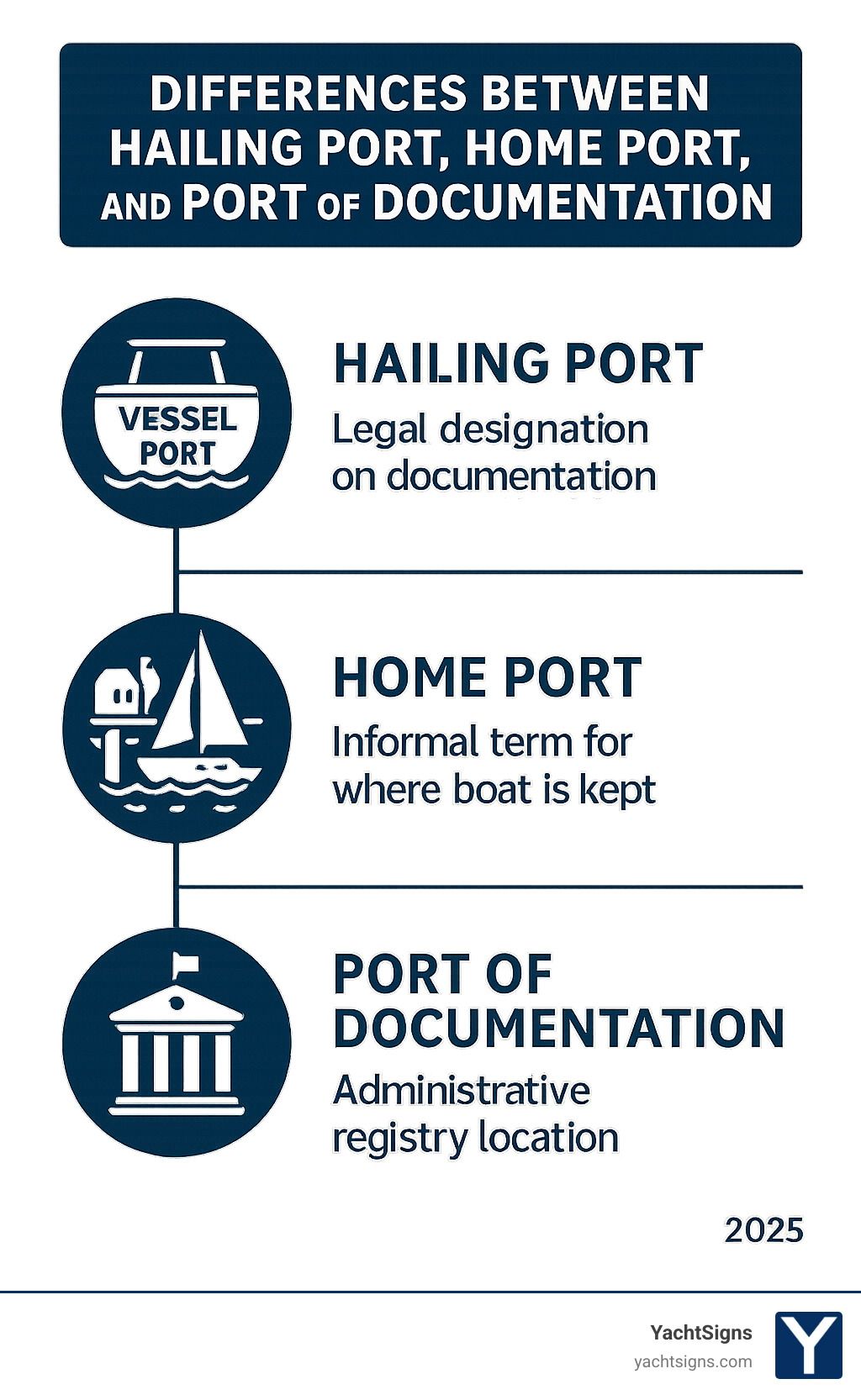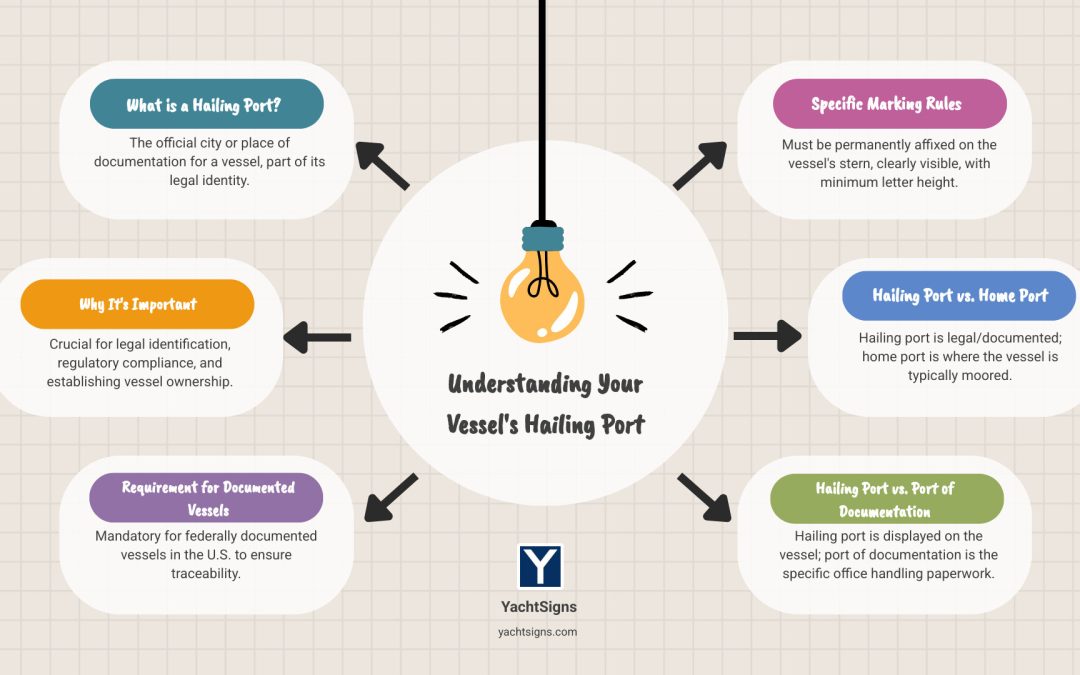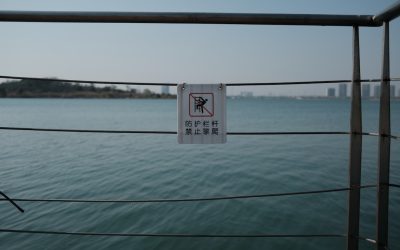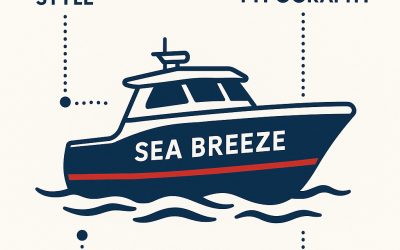Understanding Your Vessel’s Legal Identity
A boat hailing port is the designated location from which your vessel officially claims origin, displayed prominently on your boat’s stern alongside its name. This isn’t just decorative lettering – it’s a legal requirement for all US Coast Guard documented vessels and serves as your boat’s official identity marker.
Key Facts About Boat Hailing Ports:
- Legal Requirement: Mandatory for all USCG documented vessels
- Location Flexibility: Can be any US city or town (even landlocked locations)
- Display Standards: Must be at least 4 inches tall on the vessel’s stern
- Official List: Must come from the US Department of Commerce’s FIPS Publication 55DC
- Owner’s Choice: Doesn’t have to match where you live or dock your boat
Whether you’re cruising international waters or docked at your home marina, your hailing port tells the world where your vessel “calls home” – even if that home is hundreds of miles from the nearest ocean.
The choice of hailing port is deeply personal for many yacht owners. As one boat owner shared, “I chose San Francisco as my hailing port because it seemed easier to cut conversations short” when dealing with customs officials, rather than explaining a lesser-known location.
Why This Matters for Your Yacht
Your hailing port affects everything from customs clearance in foreign ports to vessel identification during emergencies. It’s also permanently displayed on your yacht’s transom, making it a key part of your vessel’s visual identity and aesthetic appeal.
At YachtSigns, we’ve crafted custom yacht signage for thousands of projects across nearly two decades. Our expertise in boat hailing port display requirements ensures your vessel meets USCG compliance while reflecting your personal style through premium, USA-manufactured craftsmanship.

What is a Hailing Port and Why is it Important?
Understanding what a boat hailing port means is like learning the first name of your vessel’s legal identity. It’s far more than decorative lettering on your yacht’s stern – it’s a fundamental requirement that connects your boat to maritime law, safety protocols, and centuries of seafaring tradition.
Your boat hailing port serves as the primary vessel identification system used by authorities worldwide. When coast guards, harbor masters, or customs officials need to identify your yacht, they look for this designation first. It’s what makes your “Sea Dreams” different from the dozens of other boats sharing that same name across American waters.
The legal requirement aspect isn’t optional territory. The US Coast Guard mandates that all federally documented vessels display their hailing port prominently on the stern. This compliance requirement ensures that every documented yacht can be properly tracked, registered, and identified within the federal system.
But there’s something beautifully traditional about hailing ports that goes beyond legal paperwork. The practice traces back to maritime customs where captains would “hail in” to port authorities, announcing their vessel’s origin. While the Collection of Customs Duties Act of 1848 formalized these requirements, the spirit remains the same – your boat carries the identity of a place, creating a connection between vessel and shore.
Safety and rescue operations rely heavily on accurate hailing port information. When emergencies strike at sea, having this clear identification helps coast guard teams respond faster and more effectively. Your hailing port becomes part of your vessel’s permanent record, making it easier for authorities to track ownership history and communicate with relevant parties during critical situations.
The boat hailing port also weaves itself into your yacht’s story and character. Whether you choose your hometown, a favorite cruising destination, or a place that holds special meaning, this designation becomes part of your vessel’s permanent narrative – a maritime address that follows your boat wherever it travels.
Defining the Hailing Port
At its heart, a hailing port represents an official designation – a specific place name that your vessel claims as its legal origin. This isn’t a casual choice you make at the marina; it’s a formal decision recorded on your vessel’s Certificate of Documentation (CG-1270) issued by the US Coast Guard.
The beauty of hailing port selection lies in its flexibility. Your boat hailing port doesn’t need to match where you physically keep your yacht. Your vessel might spend its days moored in Fort Lauderdale, but legally claim Aspen, Colorado as its hailing port. This freedom allows yacht owners to choose locations with personal significance, business advantages, or simply places they love.
Many owners find this flexibility liberating. You’re not tied to coastal cities or even locations with water access. The official requirements focus on the place being a legitimate US location from the government’s approved list, not whether that location can actually harbor your 60-foot yacht.
The place of origin designation becomes permanent once documented, appearing on all official vessel paperwork. It’s worth noting that this location reflects your choice as the owner, not necessarily where your boat was built, purchased, or currently resides.
Hailing Port vs. Home Port vs. Port of Documentation
These three maritime terms often create confusion, but understanding their differences helps clarify your vessel’s legal standing and practical operations.
Hailing Port functions as the legal term that appears on your documentation and stern lettering. It’s the official designation you choose and display permanently on your yacht. This is what customs officials see when you enter foreign waters, and what emergency responders reference during rescue operations.
Home Port serves as the informal term most boaters use when talking about where they keep their vessel. It’s conversational language – “We keep her at our home port in Newport” – but carries no legal weight. Your home port might change seasonally or based on cruising plans, while your hailing port stays constant.
Port of Documentation represents the administrative location where your vessel’s federal paperwork is processed and maintained. This is typically a US Coast Guard regional office that handles your documentation, not necessarily connected to where you boat or your chosen hailing port.
The flag registry concept ties these together. Your documented vessel flies the US flag and carries US registration, regardless of which specific hailing port you’ve chosen. Foreign officials recognize your boat as American-flagged, with your hailing port providing additional identification details.
Understanding these distinctions helps when dealing with marina paperwork, insurance forms, and international travel documentation. Each term serves a specific purpose in the maritime world, and using them correctly demonstrates your knowledge of proper boating protocols.
What is a Hailing Port and Why is it Important?
Think of your boat hailing port as your vessel’s official hometown – it’s the place your yacht “claims” as home, even if it’s never actually been there. This designation serves as a crucial part of your vessel’s identity, going far beyond simple decoration on your transom.
The boat hailing port provides essential vessel identification that helps distinguish your yacht from the thousands of others sharing similar names. When authorities need to identify a specific vessel quickly, this designation becomes invaluable for record-keeping and safety purposes.
This isn’t just a nice tradition – it’s a legal requirement established by the US Coast Guard for all federally documented vessels. If your yacht is documented rather than just state-registered, displaying your hailing port prominently on the stern isn’t optional. It’s mandatory for USCG documentation compliance.
The roots of this practice run deep in maritime tradition. The concept traces back to the Collection of Customs Duties Act of 1848, which first required vessels to record their owner’s home port on official records. While the specific requirements have evolved over nearly two centuries, the spirit of identifying a vessel by its origin remains central to maritime law.
Your hailing port plays a vital role in safety and rescue operations. When emergencies strike at sea, having accurate hailing port information helps coast guard and rescue services quickly identify vessel details and contact appropriate authorities. This can significantly speed up response times when every minute counts.
The designation also becomes part of your vessel history and narrative. Many yacht owners choose locations that hold deep personal meaning – perhaps where they first learned to sail, where they got married, or simply a place that represents their maritime dreams.
Defining the Hailing Port
At its heart, a hailing port represents an official designation – a specific place name that your vessel claims as its place of origin. This location gets officially recorded on your vessel’s Certificate of Documentation (CG-1270), which the USCG issues for all federally documented vessels in the United States.
Here’s where many boat owners get surprised: your hailing port does not have to match your boat’s physical location. Your yacht might spend every summer in the Hamptons and every winter in Florida, but its hailing port could legally be landlocked Denver, Colorado, or mountain-surrounded Aspen.
This flexibility allows yacht owners to choose locations with personal significance, business advantages, or simply places they love – regardless of whether their vessel will ever actually visit that port.
Hailing Port vs. Home Port vs. Port of Documentation
The maritime world loves its terminology, and these three similar-sounding terms often create confusion. Understanding their differences is essential for proper vessel management and compliance.
| Feature | Hailing Port | Home Port | Port of Documentation |
|---|---|---|---|
| Definition | Legal term – official designation displayed on vessel’s stern and listed on documentation | Informal term – where the boat is typically kept or operated from | Administrative location – where the vessel’s documentation is processed and maintained |
| Legal Status | Required by law for documented vessels | No legal standing | Official registry location |
| Flexibility | Owner’s choice from approved FIPS list | Can change based on boat’s location | Determined by USCG documentation office |
| Display | Must be permanently marked on transom | Not displayed on vessel | Not displayed on vessel |
| Purpose | Vessel identification and maritime tradition | Practical reference | Administrative processing |
The hailing port serves as your vessel’s legal identity marker, while your home port is simply where people might expect to find your boat. Your port of documentation is purely administrative – it’s where the paperwork gets processed, much like how your car’s title might be processed in a state capital you never visit.
Understanding these distinctions helps ensure you’re compliant with regulations while making informed decisions about your vessel’s official identity.
Why is a Hailing Port required for documented vessels?
The boat hailing port requirement isn’t just bureaucratic red tape – it’s a cornerstone of maritime safety and vessel management that has evolved from centuries of seafaring tradition. When the U.S. Coast Guard mandates this designation for federally documented vessels, they’re building on a system that has kept mariners safe and organized since the ‘Collection of Customs Duties Act’ of 1848.
Legal identification forms the foundation of why hailing ports matter. Your vessel’s Certificate of Documentation (CG-1270) officially records this designation, creating a unique legal identifier that helps authorities track and manage the thousands of vessels operating in U.S. waters and beyond. Think of it as your boat’s permanent address in the maritime world.
For enforcement and compliance, the combination of your vessel’s name and hailing port gives law enforcement, customs officials, and maritime authorities instant access to verify your documentation status. When a Coast Guard cutter approaches your yacht off the coast of Florida, that clearly displayed hailing port helps them quickly confirm your vessel’s legitimacy and documentation.
The safety and rescue aspect cannot be overstated. During emergencies, your vessel’s name and boat hailing port provide search and rescue teams with crucial information about your boat’s likely area of operation or home base. Even if you’re hundreds of miles from your designated port, this information helps responders coordinate more effective rescue operations and allows other mariners to report incidents more accurately.
When you’re traveling internationally, your hailing port serves as your vessel’s national origin identifier. Foreign customs and immigration officials use this information, along with your documentation, to establish your boat’s flag state – essential for smooth clearance procedures in ports from the Bahamas to the Mediterranean.
Perhaps most practically, your hailing port helps with vessel distinction. With popular names like “Sea Dream” or “Endless Summer” appearing on multiple yachts, the unique combination of vessel name and hailing port eliminates confusion. This becomes especially important during radio communications or when filing float plans.
The USCG’s role in producing documentation for U.S.-registered vessels makes the hailing port a fundamental part of their identification system – and a legal requirement that every documented vessel owner must display with pride and precision.
What are the specific marking requirements for a hailing port on a vessel?
Getting your boat hailing port markings right isn’t just about following rules – it’s about creating a professional appearance that reflects your vessel’s quality. At YachtSigns, we’ve helped thousands of yacht owners steer these requirements while creating signage that truly improves their vessel’s aesthetic.
The USCG has specific standards that every federally documented vessel must follow. Your vessel’s name and boat hailing port must be displayed together on the stern of your vessel – specifically on a clearly visible exterior part. For most recreational vessels, this means the transom area where both markings can be easily read.
Size matters when it comes to compliance. The characters must be at least four inches in height – this isn’t just a suggestion, it’s a firm requirement. We often recommend going slightly larger when the vessel size allows, as it improves readability and creates a more proportional look.
Legibility is everything. Your markings need to be clearly readable, which means choosing colors and fonts that create strong contrast against your hull. A dark blue hull needs light lettering, while a white hull calls for darker characters. This is where our experience really shows – we know which combinations work best in marine environments.
The characters themselves must use the Latin alphabet or Arabic or Roman numerals. No fancy symbols or decorative fonts that might look stylish but fail inspection. The regulations, specifically outlined in the Code of Federal Regulations (46 CFR § 67.123), ensure uniformity across all documented vessels.
Durability is perhaps the most critical aspect that many boat owners underestimate. Your markings must withstand years of sun, salt spray, and weather without fading or peeling. This is where professional-grade materials and proper installation techniques make all the difference.
We’ve seen too many beautiful yachts with faded, peeling letters that not only look unprofessional but could potentially cause compliance issues. Quality signage is an investment in your vessel’s appearance and legal standing.
How does a hailing port differ from a home port or port of documentation?
Understanding the distinction between these maritime terms can save you confusion when dealing with vessel documentation and compliance. While they’re often mixed up in casual conversation, each serves a different purpose in boat ownership.
Your boat hailing port is the official designation that appears on your vessel’s Certificate of Documentation and must be displayed on your stern. Think of it as your boat’s “official hometown” – it’s a legal term that becomes part of your vessel’s permanent identity. This designation stays with your boat through ownership changes and relocations.
The home port, on the other hand, is simply an informal way to describe where you actually keep your boat. If you dock at Marina del Rey but your hailing port is listed as “Newport Beach,” there’s no legal issue. Your home port changes whenever you move your vessel to a new regular berth or storage location.
Port of documentation refers to the administrative location where your vessel’s federal documentation is processed and maintained. This is typically a USCG regional examination center, not a place you choose based on personal preference.
| Feature | Hailing Port | Home Port | Port of Documentation |
|---|---|---|---|
| Legal Status | Official legal designation | Informal term | Administrative location |
| Display Requirement | Must appear on vessel stern | Not displayed | Not displayed on vessel |
| Owner’s Choice | Yes, from approved FIPS list | Yes, wherever boat is kept | No, determined by USCG |
| Documentation | Listed on Certificate of Documentation | Not on official documents | Processing location only |
| Permanence | Remains until officially changed | Changes with boat location | Set by Coast Guard region |
The key difference is that your boat hailing port is about legal identity and compliance, while your home port is simply where you actually use your vessel. At YachtSigns, we’ve helped thousands of boat owners display their chosen hailing ports with pride, creating durable signage that meets USCG requirements while reflecting their personal connection to that special place.






